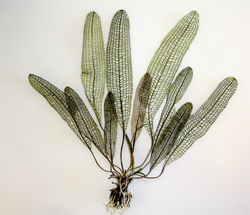What causes autumn leaves to fall? How do humans develop fingers? The answers to these questions and many of lifeŌĆÖs mysteries lie in programmed cell death (PCD), the process by which cells purposefully die.
PCD destroys cells in tree leaves when they are no longer useful and kills cells in fetal hands to separate fingers. Essentially, PCD kills certain cells so the rest of an organism can thrive.
Recently, and a team of ╣·├±▓╩Ų▒ students (, and Jaime Wertman) became the first scientists to observe the order of cellular events that occur as part of lace plant PCD, and the first to determine the time course for it. Understanding this process ŌĆö the manner by which the lace plant purposefully creates holes in its leaves ŌĆö is among the first steps in being able to regulate cell death in plants.
This could have huge implications in advanced cell biology research, agriculture and medicine.
ŌĆ£In agriculture, altering the course of PCD could create plants engineered for longer shelf life and designer florae with ŌĆśbuilt-inŌĆÖ leaf patterns,ŌĆØ explains Dr. Gunawardena. ŌĆ£In medicine, altering the course of PCD could mean huge strides toward protecting brain cells in those affected by AlzheimerŌĆÖs disease and killing unwanted cancer cells.ŌĆØ
A discovery worth the wait
It took PhD student Adrian Dauphinee 72 long hours to observe PCD in the lace plant from start to finish. Armed with a custom-built homemade slide, a Nikon 90i research microscope and a lace plant specimen, Adrian spent several days in the Gunawardena lab. He meticulously adjusted the microscope as needed, leaving it for no longer than an hour at any point.
 PhD student Christina Lord explains that Dauphinee needed to ŌĆ£babysitŌĆØ the slide because the microscope didnŌĆÖt maintain its focal plane over a long period of time.
PhD student Christina Lord explains that Dauphinee needed to ŌĆ£babysitŌĆØ the slide because the microscope didnŌĆÖt maintain its focal plane over a long period of time.
ŌĆ£The initial focus system was not adequate for work this sensitive, resulting in dozens of hours of filming for few publishable results,ŌĆØ she says.
Dauphinee elaborates: ŌĆ£The imaging project used a whole leaf that was still growing, which is one of the reasons the microscope had to be monitored continuously . . . Thankfully, I had a good book on cell biology to keep me company.ŌĆØ
The 72-hour process revealed a predictable pattern of PCD in lace plants, which you can watch unfold . The death starts in the cellŌĆÖs centre and moves outward. Interestingly, the outermost layers are spared from death. This discovery inspires new questions about why some cells die while others donŌĆÖt.
Applying findings to health issues
ŌĆ£The next step is to induce death in the areas that donŌĆÖt die and to reduce death in the areas that do,ŌĆØ explains Dr. Gunawardena. ŌĆ£This could possibly give us insight into how to reduce cell death in diseases like AlzheimerŌĆÖs while increasing death in

